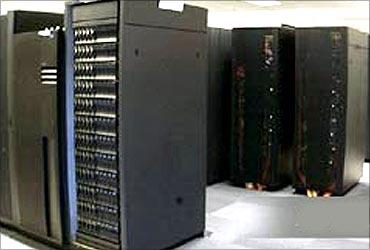
"It's always easy to do the next step and it's always impossible to do two steps time." Seymour Cray
In a major setback to India's supercomputing capabilities, its fastest supercomputer, EKA slipped from being ninth fastest supercomputer in the world to be ranked at 33, in the latest rankings of the world's 500 fastest supercomputers.
EKA, developed by Computational Research Laboratories is owned by the Tata Group.The Indian supercomputer PARAM Yuva Cluster which was ranked at 109 in June 2009 has now slipped to 183.
India is now behind United States, France, Germany and China. Twenty-four supercomputers on the list are now in China, with Germany at fourth place behind the US, the UK and France. The US has maintained its dominance with 282 out of 500 supercomputers.
Supercomputers are super achievers, giving highest and most enviable performance at any given time. Cray 1, released in 1975, is considered to be the first real supercomputer.
Supercomputers were designed primarily by Seymour Cray, who started his own firm Cray Research Inc after leaving Control Data Corporation.
The Cray-1 cost between $5-10 million to build, and had a memory of 4MW semiconductor and speed of 160 MFLOPS (MFLOPS stands for one million floating-point operations per second).
Building supercomputers was a passion for Seymour Cray. Today, supercomputers are developed by companies like Cray, IBM and Hewlett-Packard.
Click NEXT to know more about out the world's top 10 supercomputers...
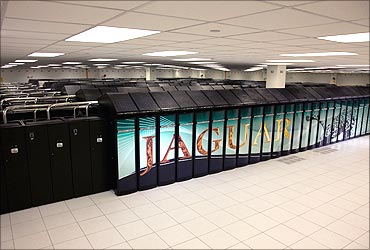
Jaguar is the world's fastest supercomputer. Build by the Cray company, it is located at the Department of Energy's Oak Ridge Leadership Computing Facility. It tops the list with its record 1.75 petaflop/s performance speed running the Linpack benchmark.
Jaguar has a theoretical peak capability of 2.3 petaflop/s and nearly a quarter of a million cores. One petaflop/s refers to one quadrillion calculations per second. It can do as many calculations in a day as a normal computer can in 100 years.
...
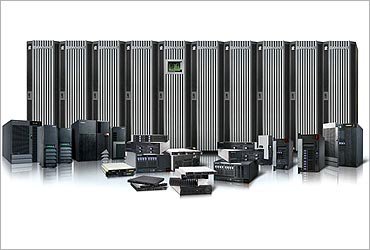
2. Nebulae
China has stormed to the supercomputing arena with Nebulae build from a Dawning TC3600 Blade system with Intel X5650 processors and NVidia Tesla C2050 GPUs.
Nebulae is currently the fastest system worldwide in theoretical peak performance at 2.98 PFlop/s. With a Linpack performance of 1.271 PFlop/s it holds second position on the 35th edition of the TOP500 list of supercomputers.
Nebulae is only the third supercomputer to break the petaflop performance barrier.
...
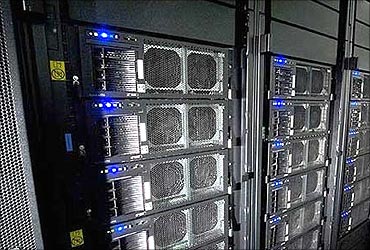
Roadrunner, which was the first ever petaflops system at Los Alamos in June 2008, dropped to No. 3 with a performance of 1.04 petaflops.
IBM maintains a clear lead in the TOP500 list in performance with 33.6 per cent of installed total performance (down from 35.1 per cent), compared to HP with 20.4 per cent (down from 23 per cent).
In the performance category, the manufacturers with more than 5 per cent are: Cray (14.8 per cent of performance) and SGI (6.6 per cent), each of which benefits from large systems in the TOP 10.
IBM and Hewlett-Packard continue to sell the bulk of systems at all performance levels of the Top 500.
HP lost its narrow lead in systems to IBM and has now 185 systems (37 per cent) compared to IBM with 198 systems (39.8 per cent). HP had 210 systems (42 per cent) six months ago, compared to IBM with 186 systems (37.2 per cent).
...
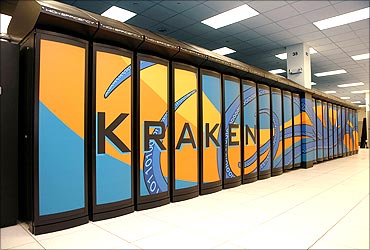
The Cray XT5-HE system at the National Institute for Computational Sciences (University of Tennessee) is fourth in the list of supercomputers.
Its processor is AMD x86_64 Opteron Six Core, 2600 MHz (10.4 GFlops). It has a peak performance of 1.03 PetaFLOP
Quad-core processor based systems have saturated the TOP500 with now 425 systems using them. However, processor with six or more cores per processor can already be found in 25 systems.
...
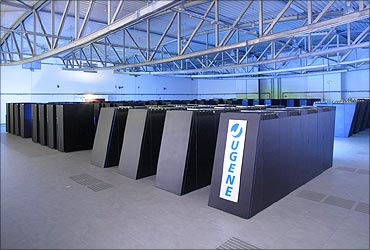
Jugene is the most powerful system in Europe. The IBM BlueGene/P supercomputer located at the Forschungszentrum Juelich (FZJ) in Germany, it achieved 825.5 teraflop/s on the Linpack benchmark.
A total of 408 systems (81.6 percent) are now using Intel processors. This is slightly up from six months ago (402 systems, 80.4 percent). Intel continues to provide the processors for the largest share of TOP500 systems.
The AMD Opteron is the second most common used processor family with 47 systems (9.4 percent), up from 42.
They are followed by the IBM Power processors with 42 systems (8.4 per cent), down from 52.
...

NASA's premiere supercomputer, Pleiades, grabbed the sixth spot on the Top500 list of the world's most powerful computers.
The Pleiades supercomputer is an SGI Altix ICE system with 14,080 Intel Xeon quad-core processors (56,320 cores, 110 racks) running at 544 trillion floating point operations per second (teraflops) on the Linpack benchmark, the industry standard for measuring a system's floating point computing power.
One of the most powerful general-purpose supercomputers ever built, Pleiades also features the world's largest InfiniBand interconnect network.
...
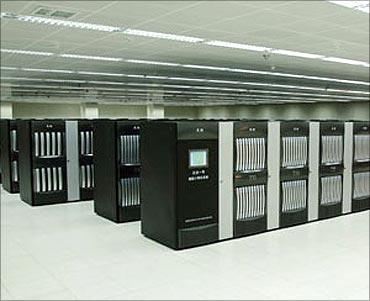
Tianhe-1 installed at the National Super Computer Center in Tianjin, China is a second Chinese system in the Top 10 list.
Tianhe-1 and Nebulae are both hybrid designs with Intel Xeon processors and AMD or NVidia GPUs used as accelerators. Each node of Tianhe-1 consists of two AMD GPUs attached to two Intel Xeon processors.
The performance of Nebulae and Tianhe-1 were enough to catapult China in the No.2 spot of installed performance (9.2 percent) ahead of various European countries, but still clearly behind the US (55.4 per cent).
...
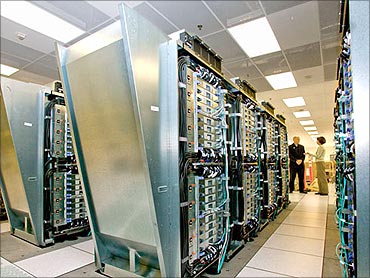
8. BlueGene/L
IBM's BG/L and successor systems represent a revolutionary, cost efficient design for high-performance computing systems, with significantly lower power requirements and a smaller footprint than previous supercomputing systems.
BG/L held the No. 1 position in the Top500 list of the world's fastest supercomputers seven times running over three years (November 2004 to June 2008).
The Blue Gene/L machine was designed and built in collaboration with the Department of Energy's NNSA/Lawrence Livermore National Laboratory in California, a peak speed of 596 teraflops (trillion floating operations per second).
...
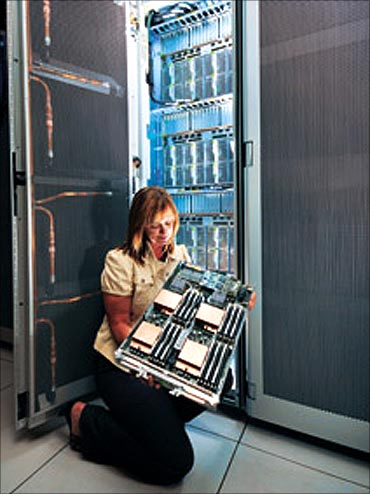
The IBM Blue Gene/P Solution also known as Intrepid is a follow-on product to the successful Blue Gene/L Solution.
The Blue Gene family of supercomputers has been designed to deliver ultrascale performance within a standard programming environment while delivering efficiencies in power, cooling and floor-space consumption.
Many universities and government research labs have deployed Blue Gene for computational studies in weapons research, radio astronomy, protein folding, climate research, cosmology, and drug development.
...
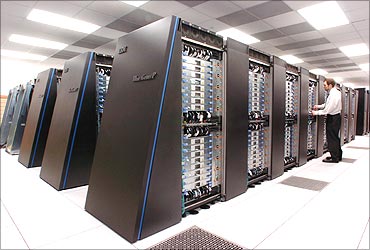
10. Red Sky
Red Sky will deliver more than 160 tera-flops peak performance.
Designed to be expanded economically to several times this initial capacity to meet future growth in demand, the new Red Sky supercomputer from Sandia National Laboratories just debuted as the 10th fastest supercomputer on the Top500 list, with a sustained performance of 429.9 teraflops.
Red Sky consists of 68 cabinets of Sun Constellation gear, with up to 96 nodes and 678 cores per rack. Each cabinet can each require up to 32 kilowatts of energy at full load.
But the system is notable not just for its power, but for its energy efficiency. Red Sky has an estimated power usage effectiveness (PUE) of 1.035.